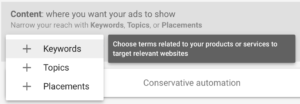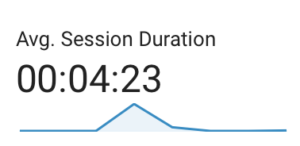Most of you have probably already experienced a huge volume of clicks with very few conversions while running display ad campaigns on the Google network. Does it mean that display network advertising is not working for you? Not necessarily. If your landing page is well optimised for conversions, a high volume of clicks may just mean that your targeting is too broad or that you’re getting irrelevant clicks. Here are a few things to check to improve the quality of your traffic.
1. Banner design: don’t grab people’s
attention too much
One of the first rules of marketing is to offer special incentives for users to register to your website. But unless you have a consumer oriented product or service that could be used by everyone, you will want to avoid advertising a free iPad for every signup for example. This will only trigger a majority of irrelevant clicks, people obviously only interested in the offer and not at all in your products or services.
Once they land on your website, they will quickly realise they won’t be able to get an iPad if they don’t buy your product and will leave the page immediately. Try to have banners relevant to your target audience that explain in a few words the benefits of your product or service. A relevant call to action will also be needed. The next step will be to display those banners on relevant websites.
2. Display keywords: beware of homonyms
This is one of the targeting methods offered by Google on their display network. You will choose keywords related to your activity and your ads will show on websites where these keywords appear. There are no match types for these, meaning that they will all be considered as broad.
It is therefore highly recommended to start with a small quantity of keywords, and to check them one by one in search
 engines. Anytime you see some irrelevant results, just remove the keyword from your list. As an example, someone may want to target marketing websites mentioning the word ‘conversion’ on their pages. While some of the placements will be relevant, the vast majority will be websites about measurement conversions such as weight, volume and distance which will be highly irrelevant to your target audience. So be extremely cautious when it comes to choosing your keywords.
engines. Anytime you see some irrelevant results, just remove the keyword from your list. As an example, someone may want to target marketing websites mentioning the word ‘conversion’ on their pages. While some of the placements will be relevant, the vast majority will be websites about measurement conversions such as weight, volume and distance which will be highly irrelevant to your target audience. So be extremely cautious when it comes to choosing your keywords.
Alternatively, you can try to keep those keywords if you deem them highly relevant to your activity; what you will need to do is build lists of negative keywords that will prevent your ads from showing on irrelevant websites. This can be an arduous task and you will never be able to predict them all, but it’s worth a try.
3. Topics: discover new placements
The Google Display Network has custom lists of websites you can choose from, arranged by categories and sub categories: Business & Industrial, Computers & Electronics, etc. The downside to this targeting method is that it’s very broad and you will appear on very generic websites about finance or business for example, if that’s the topics you’ve chosen. It then makes it very difficult to get some quality traffic from your ads. On the other hand, if you run it on a small daily budget, it can help you find new quality placements for your ads over a longer period of time.
4. Placements: a long-term but rewarding job
This is the best method to get some highly targeted traffic. The difficulty of this approach is that you will have to build a list of websites where you want your ads to appear. This should be done on a daily basis: anytime you find a website relevant to your target audience, add it to your placements list. Ads should also be tailored for those specific websites and users. Check who’s already advertising on these, and target your message to this specific audience. This will be a long term process but extremely rewarding in the end.
5. Traffic quality: Google Analytics is your friend
Whatever targeting methods you choose, you will now need to check the quality of the traffic you’re generating from these display campaigns. The first indicator will of course be the quality of your conversions. But there are several other factors that can help you determine whether you receive quality traffic or not:
-
-
Average visit duration
 This is a good indicator of the quality of the traffic. The longer a visitor stays on your website, the more he’s likely to be interested in your products and services. In Google Analytics, you will be able to view reports for each campaign. Check if there are visits below your targeted or average visit duration and remove websites or keywords triggering those visits.
This is a good indicator of the quality of the traffic. The longer a visitor stays on your website, the more he’s likely to be interested in your products and services. In Google Analytics, you will be able to view reports for each campaign. Check if there are visits below your targeted or average visit duration and remove websites or keywords triggering those visits.
-
-
-
Referrer URL’s
While Google Adwords will sometimes be unable to show you all websites where your ads appeared (value ‘not set’), Google Analytics can do this for you. And the URL of a website is enough most of the time to determine whether it’s relevant to your activity or not. Build your list of negative placements this way and upload it to your display campaigns.
-
-
Bounce rate
Along with the average visit duration, this is another good indicator of the quality of the traffic. Although the bounce rate will always be higher for display campaigns than for search ads for example, it should still be within acceptable limits.
Now what is an acceptable limit? It’s difficult to say unfortunately, as it will depend on your industry, your landing page and several other factors. The best way to calculate it is to take one of your successful campaigns as a benchmark. For example, if in addition to Google Display Network campaigns, you’re running a Google Search campaign with a good conversion rate, your GDN bounce rate should typically be 10 to 20% higher than your search campaign.
But once again, these are just ballpark figures and the aim will still be to reduce this bounce rate significantly over time.
6. Mobile app clicks: perpetual accidents?
 Mobile app ads are becoming more and more popular these days. While they may generate profitable traffic for some businesses, it is very difficult for most advertisers to see any benefits in them. There are so many tricks to trigger accidental clicks these days inside mobile apps that it makes it impossible to trust this advertising approach.
Mobile app ads are becoming more and more popular these days. While they may generate profitable traffic for some businesses, it is very difficult for most advertisers to see any benefits in them. There are so many tricks to trigger accidental clicks these days inside mobile apps that it makes it impossible to trust this advertising approach.
The Google Display Network offers automatic mobile app targeting, so after a few days running your campaigns, check the average visit duration of those mobile app clicks. If you see that the majority of them are 0.1 sec, these are accidental clicks. It is then recommended to exclude mobile apps from your targeting. To do so, add adsenseformobileapps.com to your site exclusions or tick GMob mobile app non-interstitial as an exclusion.
![]() Getting your Google display campaigns to generate quality traffic and conversions takes time and effort. The first few weeks will be devoted to traffic exclusions and ad testing; then it will be a constant drill down until you’ve built a significant placements list. The tracking of your campaigns should be intricate, with all placements, ads and keywords tracked individually. This will help you analyse the performance of each of those in greater detail. Once this filtering work is done, you will enjoy quality traffic and conversions, as well as an increase in brand awareness for your business across multiple websites.
Getting your Google display campaigns to generate quality traffic and conversions takes time and effort. The first few weeks will be devoted to traffic exclusions and ad testing; then it will be a constant drill down until you’ve built a significant placements list. The tracking of your campaigns should be intricate, with all placements, ads and keywords tracked individually. This will help you analyse the performance of each of those in greater detail. Once this filtering work is done, you will enjoy quality traffic and conversions, as well as an increase in brand awareness for your business across multiple websites.


